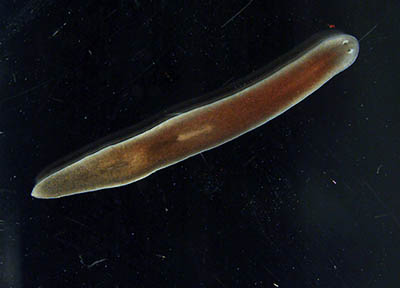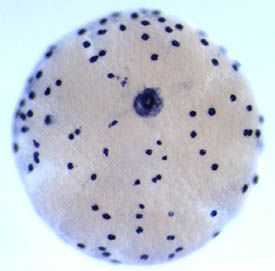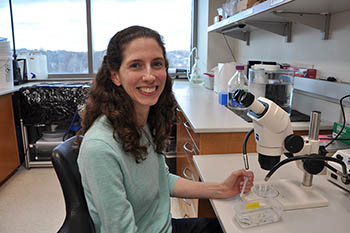Using Flatworm Regeneration To Study Stem Cells
Erin Davies Brings Flatworm Animal Model to NIH
The key to unlocking mysteries surrounding regenerative medicine could lie within worms—tiny, flat, cross-eyed worms. Recently hired Stadtman Investigator Erin Davies (National Cancer Institute, NCI) is the first in the NIH intramural research program to use flatworms (Schmidtea mediterranea), or planaria, as an animal model to explore stem cells at different developmental stages.

CREDIT: ERIN DAVIES, NCI
Erin Davies is using the flatworm Schmidtea mediterranea, which has an amazing ability to regenerate, to study pluripotent stem cells.
Planarians are flatworms that possess an amazing ability to regenerate themselves. If you cut one planarian down the middle, each half would reform its missing parts, and you would have two planarians in a matter of weeks. Although humans and other mammals possess some regenerative ability, such as the ability to heal wounds, we are not nearly as capable as these flatworms. Davies is determined to figure out why.
She was introduced to the planarian model by her postdoctoral advisor, Alejandro Sánchez Alvarado, at the Stowers Institute for Medical Research (Kansas City, Missouri). Sánchez Alvarado provided a unique opportunity for Davies to study the planarian S. mediterranea, a long-lived species that can reproduce both sexually and asexually and has a seemingly inexhaustible capacity to regenerate itself.

CREDIT: ERIN DAVIES, NCI
This image pictures a Stage 3 embryo of the flatworm Schmidtea mediterranea stained with riboprobes. The blue belly button-like structure is the embryonic pharynx; the small blue circles are undifferentiated embryonic cells. Embryogenesis lasts for approximately two weeks for this flatworm species. Scale bar: 100 microns.
During her postdoctoral training, she pioneered molecular and functional studies of embryogenesis in S. mediterranea and was able to observe the cellular mechanisms that guide development through the planarian’s life cycle. When she finished her training, she was eager to continue that research in her own lab. She applied to NIH’s competitive Earl Stadtman Investigator program and was hired by NIH in 2020 to work in NCI’s Cancer and Developmental Biology Laboratory, where she heads the Potency and Developmental Plasticity Section.
Planarians have adult pluripotent stem cells (PSCs) that fuel tissue homeostasis and regeneration. In most animals (including mammals), however, PSCs are only present in embryos and are primarily responsible for the development of organs, limbs, and tissues.
“The planarian has found a way to sustain embryonic pluripotency programs throughout [its] life cycle,” Davies explained. What’s more, planarian PSCs can readily proliferate without causing the organism to age or develop cancer.

CREDIT: MOL MIR, STOWERS INSTITUTE FOR MEDICAL RESEARCH
Erin Davies in her lab at Stowers Institute where she was a postdoc before coming to NIH.
Through her research, Davies is exploring whether the nature of planarian pluripotency changes throughout the life cycle and just how that pluripotency is maintained. A greater understanding of the planarian regenerative system could have implications for treating cancer, degenerative diseases, and other conditions.
“I think that there are a number of unique opportunities in not only planarians, but other lower invertebrates…to address key concepts and principles, like the evolution of tumor suppression or other facets,” she said. “Simpler models like planarians, sponges, [and] hydra…can offer a unique evolutionary perspective [on] how some of these systems evolved…and how some embryonic developmental programs can be repurposed.”
“Planarians are a remarkable model system,” said NCI-CCR Scientific Director Tom Misteli. “Its arrival in the intramural program offers a powerful new tool to study regeneration, differentiation, and stem-cell biology, all processes that are highly relevant to many diseases including cancer.”
Although setting up her NIH lab during the COVID-19 pandemic has been challenging, Davies is brimming with enthusiasm at the prospect of getting back to work investigating the mysterious abilities of these cross-eyed creatures.

Megan Kalomiris is a postbaccalaureate fellow in the Laboratory of Infectious Diseases (National Institute of Allergy and Infectious Diseases), where she studies noroviruses. After completing her training in 2021, she plans to pursue a master’s degree in science writing with hopes of working in science communications some day. In her spare time, she enjoys taking walks in the woods and playing games (now, virtually) with her friends.
This page was last updated on Tuesday, March 22, 2022
